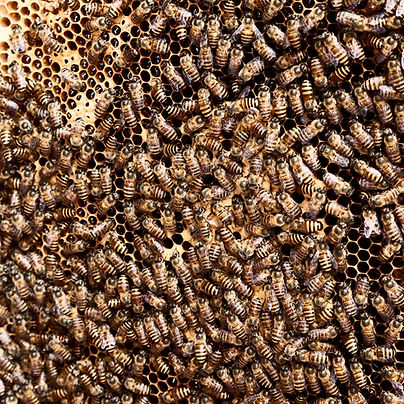
MAKING SPLITS
DEMAREE SPLIT
The Demaree split is a method of swarm prevention in beekeeping that involves temporarily splitting the hive into two parts, separating the brood nest from the honey storage area, and creating additional space for the bees to prevent them from feeling crowded and swarming.
During a Demaree split, the beekeeper locates the queen and some frames of brood and bees and moves them to a new brood box placed on top of the original hive. The queen is prevented from accessing the original hive by using an excluder to block her access. The beekeeper then places empty frames between the brood frames in the original hive to create more space for the bees to store honey. A queen excluder is placed between the new brood box and the old hive to prevent the queen from laying eggs in the upper box and to keep the bees in the lower box.
By temporarily separating the brood and honey storage areas and creating additional space for the bees, the Demaree split can be an effective way to prevent swarming and increase honey production. The method is typically done during the spring or early summer when the bees are most likely to swarm. After a few days, the hive can be reassembled and the bees will reorganize and adjust to the new space configuration.
Materials: For this process you will need a brood box, frames and a queen excluder. Later, you will need a stand, floor, supers, crown board and a roof.
Process:
-
Remove the roof, turn it upside down and place to one side.
-
Remove the crown board and place this to one side on top of the roof.
-
Remove the supers and place these to one side on top of the crown board.
-
Remove the queen excluder and check that the queen is not on the underside, now place this to one side on top of the supers.
-
Lift the existing brood nest off the floor and temporarily move this to the side.
-
Place the new brood box complete with foundation onto the existing floor, leave a gap for one frame.
-
Find the queen and capture her.
-
Find a frame full of capped brood from the original brood box that you moved to the side and check it to ensure there are no queen cell.
-
Take the frame with capped brood and place it into the middle of the new brood box with the foundation and close up any gaps on the frames.
-
Place the queen in the new brood box.
-
Place the queen excluder that you put to one side onto the new brood box that now contains the queen.
-
Place the frame of foundation from the new brood box (where you placed the queen) and put it to the end of the existing brood nest, close up any gaps.
-
Replace the supers that you put to one side onto the new brood box above the queen excluder, add additional if you like to give space.
-
Add the new queen excluder to the top of the supers.
-
Go through the frames of the original brood nest one by one and remove all queen cups and cells.
-
Place the original brood nest on top of the queen excluder.
-
Add the crown board and the roof which you put to one side..
-
Strap the hive to the hive stand.
-
After 4 to 5 days, remove the roof, crown board and brood box and look for and destroy any queen cells or cups. If you don't do this, your colony could swarm.
-
After a further 25 days the procedure is complete.
-
The brood in the top box can now be removed for you to relocate into your new hive.
Maintain records: Beekeeping records are an important tool to manage colonies effectively and ensure the health and productivity of their bees, don't forget to record your findings.